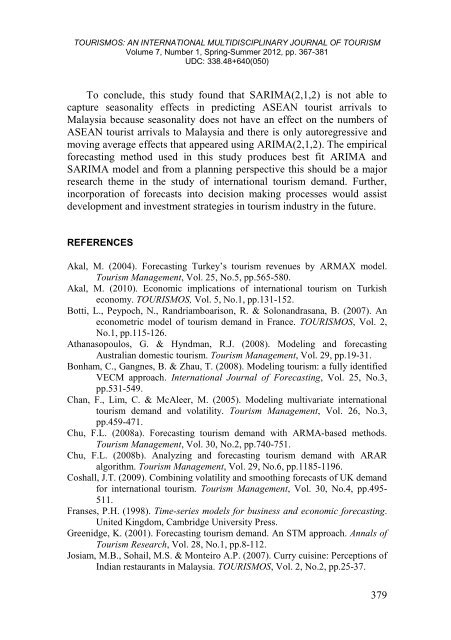is 'malaysia truly asia'? forecasting tourism demand from asean ...
is 'malaysia truly asia'? forecasting tourism demand from asean ... is 'malaysia truly asia'? forecasting tourism demand from asean ...
Loganathan Nanthakumar, Thirunaukarasu Subramaniam & Mori Kogidestimated for the sample period can be described as shown in thefollowing equation with standard errors and t-values of the coefficientsgiven in parentheses. Estimated AR(2) and MA(2) are found to besignificant at 1%. It is clear that the AR(2) and MA(2) components aresignificant without any seasonal dummies because the dummy variablesdo not determine ASEAN tourist arrivals to Malaysia:∆lnTour t = 0.02 - 0.22∆lnTour t-1 + 0.68∆lnTourist t-2 - 0.08ɛ t-1 - 0.91 ɛ t-2t-stat (7.74)* (-1.79) (5.93)* (-0.84) (-9.77)*It worth mentioning that once we accept ARIMA(2,1,2) as a suitablemodel for this study, the model is used for forecasting purpose. Weapplied ARIMA(2,1,1) to forecast one-period ahead using historical data1995:Q1 to 2009:Q4 and forecast the short-term period 2010:Q1 to2010:Q4 of tourist arrivals to Malaysia. Figure 4 shows the forecastedASEAN tourist arrivals to Malaysia using ARIMA(2,1,2) with one-periodahead forecasting method. Usage of quarterly data with short termforecasting, one-period-ahead procedure provides a slightly better forecastfor Malaysia.70000600005000040000300002000010000018.08018.15223.49639.21222.27415.75616.65266.19128.55122.85418.91417.838Jan Feb Mac Apr May Jun July Aug Sept Oct Nov DecLower (95%) Forecasted Upper (95%)378Figure 5 One-Period Ahead Forecasted ASEAN Tourist Arrival(2010:Q1- 2010:Q4)CONCLUSION
TOURISMOS: AN INTERNATIONAL MULTIDISCIPLINARY JOURNAL OF TOURISMVolume 7, Number 1, Spring-Summer 2012, pp. 367-381UDC: 338.48+640(050)To conclude, this study found that SARIMA(2,1,2) is not able tocapture seasonality effects in predicting ASEAN tourist arrivals toMalaysia because seasonality does not have an effect on the numbers ofASEAN tourist arrivals to Malaysia and there is only autoregressive andmoving average effects that appeared using ARIMA(2,1,2). The empiricalforecasting method used in this study produces best fit ARIMA andSARIMA model and from a planning perspective this should be a majorresearch theme in the study of international tourism demand. Further,incorporation of forecasts into decision making processes would assistdevelopment and investment strategies in tourism industry in the future.REFERENCESAkal, M. (2004). Forecasting Turkey’s tourism revenues by ARMAX model.Tourism Management, Vol. 25, No.5, pp.565-580.Akal, M. (2010). Economic implications of international tourism on Turkisheconomy. TOURISMOS, Vol. 5, No.1, pp.131-152.Botti, L., Peypoch, N., Randriamboarison, R. & Solonandrasana, B. (2007). Aneconometric model of tourism demand in France. TOURISMOS, Vol. 2,No.1, pp.115-126.Athanasopoulos, G. & Hyndman, R.J. (2008). Modeling and forecastingAustralian domestic tourism. Tourism Management, Vol. 29, pp.19-31.Bonham, C., Gangnes, B. & Zhau, T. (2008). Modeling tourism: a fully identifiedVECM approach. International Journal of Forecasting, Vol. 25, No.3,pp.531-549.Chan, F., Lim, C. & McAleer, M. (2005). Modeling multivariate internationaltourism demand and volatility. Tourism Management, Vol. 26, No.3,pp.459-471.Chu, F.L. (2008a). Forecasting tourism demand with ARMA-based methods.Tourism Management, Vol. 30, No.2, pp.740-751.Chu, F.L. (2008b). Analyzing and forecasting tourism demand with ARARalgorithm. Tourism Management, Vol. 29, No.6, pp.1185-1196.Coshall, J.T. (2009). Combining volatility and smoothing forecasts of UK demandfor international tourism. Tourism Management, Vol. 30, No.4, pp.495-511.Franses, P.H. (1998). Time-series models for business and economic forecasting.United Kingdom, Cambridge University Press.Greenidge, K. (2001). Forecasting tourism demand. An STM approach. Annals ofTourism Research, Vol. 28, No.1, pp.8-112.Josiam, M.B., Sohail, M.S. & Monteiro A.P. (2007). Curry cuisine: Perceptions ofIndian restaurants in Malaysia. TOURISMOS, Vol. 2, No.2, pp.25-37.379
- Page 1 and 2: TOURISMOS: AN INTERNATIONAL MULTIDI
- Page 3 and 4: TOURISMOS: AN INTERNATIONAL MULTIDI
- Page 5 and 6: TOURISMOS: AN INTERNATIONAL MULTIDI
- Page 7 and 8: TOURISMOS: AN INTERNATIONAL MULTIDI
- Page 9 and 10: TOURISMOS: AN INTERNATIONAL MULTIDI
- Page 11: TOURISMOS: AN INTERNATIONAL MULTIDI
- Page 15: TOURISMOS: AN INTERNATIONAL MULTIDI
TOURISMOS: AN INTERNATIONAL MULTIDISCIPLINARY JOURNAL OF TOURISMVolume 7, Number 1, Spring-Summer 2012, pp. 367-381UDC: 338.48+640(050)To conclude, th<strong>is</strong> study found that SARIMA(2,1,2) <strong>is</strong> not able tocapture seasonality effects in predicting ASEAN tour<strong>is</strong>t arrivals toMalaysia because seasonality does not have an effect on the numbers ofASEAN tour<strong>is</strong>t arrivals to Malaysia and there <strong>is</strong> only autoregressive andmoving average effects that appeared using ARIMA(2,1,2). The empirical<strong>forecasting</strong> method used in th<strong>is</strong> study produces best fit ARIMA andSARIMA model and <strong>from</strong> a planning perspective th<strong>is</strong> should be a majorresearch theme in the study of international tour<strong>is</strong>m <strong>demand</strong>. Further,incorporation of forecasts into dec<strong>is</strong>ion making processes would ass<strong>is</strong>tdevelopment and investment strategies in tour<strong>is</strong>m industry in the future.REFERENCESAkal, M. (2004). Forecasting Turkey’s tour<strong>is</strong>m revenues by ARMAX model.Tour<strong>is</strong>m Management, Vol. 25, No.5, pp.565-580.Akal, M. (2010). Economic implications of international tour<strong>is</strong>m on Turk<strong>is</strong>heconomy. TOURISMOS, Vol. 5, No.1, pp.131-152.Botti, L., Peypoch, N., Randriamboar<strong>is</strong>on, R. & Solonandrasana, B. (2007). Aneconometric model of tour<strong>is</strong>m <strong>demand</strong> in France. TOURISMOS, Vol. 2,No.1, pp.115-126.Athanasopoulos, G. & Hyndman, R.J. (2008). Modeling and <strong>forecasting</strong>Australian domestic tour<strong>is</strong>m. Tour<strong>is</strong>m Management, Vol. 29, pp.19-31.Bonham, C., Gangnes, B. & Zhau, T. (2008). Modeling tour<strong>is</strong>m: a fully identifiedVECM approach. International Journal of Forecasting, Vol. 25, No.3,pp.531-549.Chan, F., Lim, C. & McAleer, M. (2005). Modeling multivariate internationaltour<strong>is</strong>m <strong>demand</strong> and volatility. Tour<strong>is</strong>m Management, Vol. 26, No.3,pp.459-471.Chu, F.L. (2008a). Forecasting tour<strong>is</strong>m <strong>demand</strong> with ARMA-based methods.Tour<strong>is</strong>m Management, Vol. 30, No.2, pp.740-751.Chu, F.L. (2008b). Analyzing and <strong>forecasting</strong> tour<strong>is</strong>m <strong>demand</strong> with ARARalgorithm. Tour<strong>is</strong>m Management, Vol. 29, No.6, pp.1185-1196.Coshall, J.T. (2009). Combining volatility and smoothing forecasts of UK <strong>demand</strong>for international tour<strong>is</strong>m. Tour<strong>is</strong>m Management, Vol. 30, No.4, pp.495-511.Franses, P.H. (1998). Time-series models for business and economic <strong>forecasting</strong>.United Kingdom, Cambridge University Press.Greenidge, K. (2001). Forecasting tour<strong>is</strong>m <strong>demand</strong>. An STM approach. Annals ofTour<strong>is</strong>m Research, Vol. 28, No.1, pp.8-112.Josiam, M.B., Sohail, M.S. & Monteiro A.P. (2007). Curry cu<strong>is</strong>ine: Perceptions ofIndian restaurants in Malaysia. TOURISMOS, Vol. 2, No.2, pp.25-37.379



